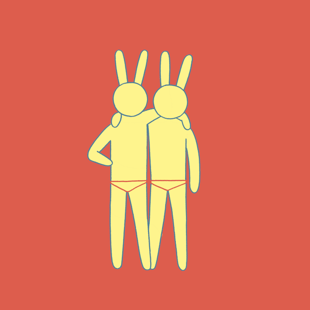

THEME: LOVE | LOVE 1: WHEN WE MET
THEME: LOVE
Love between two human beings is a subject concerning us all, including many artists: poets, filmmakers, painters, sculptors, musicians, choreographers... Many works of art sprang from longing, happiness, sorrow and all the other things the feeling of amorous fulfilment brings us. Or a loss thereof. Love is the driving force behind many sleepless nights and strong emotions forged into verbal or visual brilliance dedicated to Her or Him.
Naturally, animators are no exception – this year we are presenting a collection of animated films focusing on this beautiful and intimate subject. The choice itself doesn’t pretend to be comprehensive or complete, mainly due to the limited slot in the line-up. We made sure the programme is diverse and, in our opinion, we have compiled a very good insight into the different ways the animators, each in their respective way, tackled this eternal challenge.
This year’s festival theme has three units, the first and second with three sections, and the final consists of two eros sections... The first focuses on classic love and is arranged chronologically, so to speak – When We Met, Fire of Love and the tragic Heartbreak. This section includes some of my personal all-time favourites like Un jour by Marie Paccou or Wolves by Rafael Sommerhalder. Some films feature a hilarious take on breaking up, like 12 Years by Daniel Nocke, others are larger than life, like the protagonists’ fate in In the Neighbourhood of the City, whilst the third focus on online love, typical of the modern era – Lovestreams by Sean Buckelew.
The second unit, Menage a deux, is dedicated to animator couples. People whose private and business lives are interwoven and who have made films together in the key roles. Like in many other professions, it is not unusual that Cupid’s arrow strikes two people out of the blue, at a festival, workshop, studio. Sometimes this results in masterpieces which, as such, without these two people having met, never would have existed in this form. This theme unit includes some of the most famous couples from the history and present of animation: who hasn’t heard of the pinscreen inventors Alexandre Alexeieff and Claire Parker or the great Joy Batchelor and John Halas? Today all the animation devotees are familiar with Olga and Priit Pärn, Abi Feijó and Regina Pessoa, Wendy Tilby and Amanda Forbis, and Michelle and Uri Kranot. We have to apologise to all the unincluded couples as we were limited by programme boundaries, which forced us to stick, as we already said, to the partners in key roles – mainly co-directors and/or co-producers. As an example of a famous but unlisted couple, I’ll mention Rosto and Suzie Templeton. Of course they supported and helped each other, but their togetherness did not result in a common project which was, next to excellence, one of the criteria. Also, some famous couples ended up in other theme sections, such as Sasha and Nadja Svirsky.
The third theme section, eroticism in animation, usually happened in late-night slots, although children went to sleep after the 7.15 cartoon! This subject, a former taboo, was long approached through slapstick and humour. Over the past two to three decades a large shift happened and today depictions of physical love are a lot more sensual, lascivious, even explicit, becoming the new normal. In line with a rise in women filmmakers in the past decade or two, many of them have already presented their views on this matter with a far greater awareness than before, often more specifically and bravely than their male counterparts. The immediacy and sincerity of Signe Baumane’s films is legendary. I don’t remember ever seeing such a portrayal of masturbation from a male animator as Renata Gąsiorowska gave in her student film Pussy. Young Canadian Lori Malépart-Traversy has earned global fame with her much needed educational animation documentary Clitoris. In this context, another title to mention is the couple’s section film Girls Night Out by Joanna Quinn (and Les Mills) from the late eighties, which immediately stirred the scene with its portrayal of female sexuality.
Finally, we need to thank Nancy Denney-Phelps, Margit Antauer Buba, Olivier Catherin, Olga and Michal Bobrowski, Matea Milić, Vivien Halas, Thomas Renoldner, Sabine Groschup and all those whose suggestions and advice helped find the titles for this theme programme.
Daniel Šuljić


